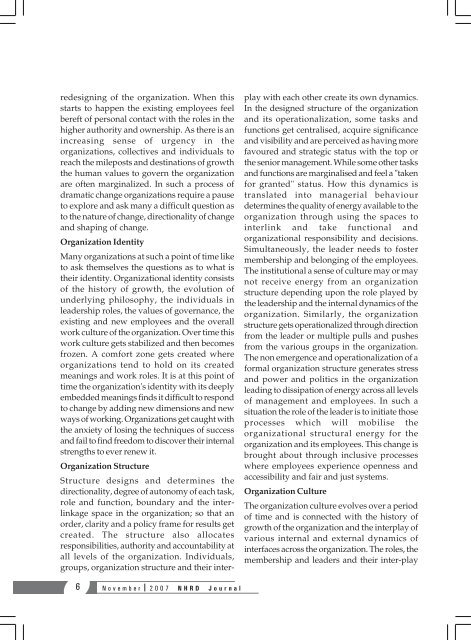NHRD Journal - National HRD Network
NHRD Journal - National HRD Network
NHRD Journal - National HRD Network
You also want an ePaper? Increase the reach of your titles
YUMPU automatically turns print PDFs into web optimized ePapers that Google loves.
edesigning of the organization. When this<br />
starts to happen the existing employees feel<br />
bereft of personal contact with the roles in the<br />
higher authority and ownership. As there is an<br />
increasing sense of urgency in the<br />
organizations, collectives and individuals to<br />
reach the mileposts and destinations of growth<br />
the human values to govern the organization<br />
are often marginalized. In such a process of<br />
dramatic change organizations require a pause<br />
to explore and ask many a difficult question as<br />
to the nature of change, directionality of change<br />
and shaping of change.<br />
Organization Identity<br />
Many organizations at such a point of time like<br />
to ask themselves the questions as to what is<br />
their identity. Organizational identity consists<br />
of the history of growth, the evolution of<br />
underlying philosophy, the individuals in<br />
leadership roles, the values of governance, the<br />
existing and new employees and the overall<br />
work culture of the organization. Over time this<br />
work culture gets stabilized and then becomes<br />
frozen. A comfort zone gets created where<br />
organizations tend to hold on its created<br />
meanings and work roles. It is at this point of<br />
time the organization's identity with its deeply<br />
embedded meanings finds it difficult to respond<br />
to change by adding new dimensions and new<br />
ways of working. Organizations get caught with<br />
the anxiety of losing the techniques of success<br />
and fail to find freedom to discover their internal<br />
strengths to ever renew it.<br />
Organization Structure<br />
Structure designs and determines the<br />
directionality, degree of autonomy of each task,<br />
role and function, boundary and the interlinkage<br />
space in the organization; so that an<br />
order, clarity and a policy frame for results get<br />
created. The structure also allocates<br />
responsibilities, authority and accountability at<br />
all levels of the organization. Individuals,<br />
groups, organization structure and their interplay<br />
with each other create its own dynamics.<br />
In the designed structure of the organization<br />
and its operationalization, some tasks and<br />
functions get centralised, acquire significance<br />
and visibility and are perceived as having more<br />
favoured and strategic status with the top or<br />
the senior management. While some other tasks<br />
and functions are marginalised and feel a "taken<br />
for granted" status. How this dynamics is<br />
translated into managerial behaviour<br />
determines the quality of energy available to the<br />
organization through using the spaces to<br />
interlink and take functional and<br />
organizational responsibility and decisions.<br />
Simultaneously, the leader needs to foster<br />
membership and belonging of the employees.<br />
The institutional a sense of culture may or may<br />
not receive energy from an organization<br />
structure depending upon the role played by<br />
the leadership and the internal dynamics of the<br />
organization. Similarly, the organization<br />
structure gets operationalized through direction<br />
from the leader or multiple pulls and pushes<br />
from the various groups in the organization.<br />
The non emergence and operationalization of a<br />
formal organization structure generates stress<br />
and power and politics in the organization<br />
leading to dissipation of energy across all levels<br />
of management and employees. In such a<br />
situation the role of the leader is to initiate those<br />
processes which will mobilise the<br />
organizational structural energy for the<br />
organization and its employees. This change is<br />
brought about through inclusive processes<br />
where employees experience openness and<br />
accessibility and fair and just systems.<br />
Organization Culture<br />
The organization culture evolves over a period<br />
of time and is connected with the history of<br />
growth of the organization and the interplay of<br />
various internal and external dynamics of<br />
interfaces across the organization. The roles, the<br />
membership and leaders and their inter-play<br />
6<br />
November 2007 <strong>N<strong>HRD</strong></strong> <strong>Journal</strong>
















